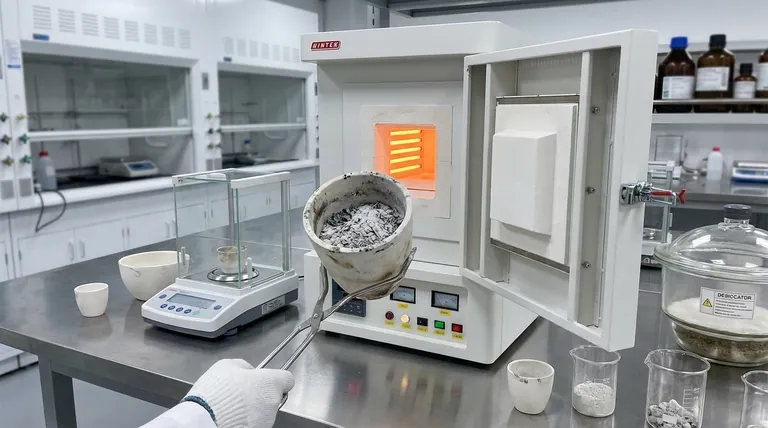In short, a high ash content indicates a high concentration of inorganic, non-combustible material within a sample. This measurement is determined by completely burning the substance and weighing the residue that remains. This residue, or "ash," typically consists of inorganic elements like minerals, metals, and fillers.
The ash content of a material is not just a measurement; it is a critical indicator of its composition, quality, and often, its intended performance. It reveals the percentage of inorganic fillers or contaminants, which directly impacts the material's physical properties and cost.

What Ash Content Fundamentally Represents
The Inorganic Remainder
Ash is the inorganic portion of a substance that does not burn away during combustion. It's what's left after all the organic components (like carbon and hydrogen) have been oxidized and removed.
This residue is typically composed of oxides of the inorganic elements present in the original sample.
A Proxy for Fillers and Additives
In many manufactured materials, particularly plastics and composites, a high ash content is intentional. It signifies the presence of inorganic fillers added to the base polymer.
Common fillers include substances like glass fibers, talc, calcium carbonate, or silica. These are added to modify the material's properties or reduce cost.
An Indicator of Purity
Conversely, for a material that is supposed to be a pure organic substance (like a virgin polymer), the ash content should be nearly zero.
In this context, a higher-than-expected ash content is a red flag for contamination, indicating the presence of unwanted inorganic impurities.
Why This Measurement is Critical
Verifying Material Composition
Quality control labs perform ash tests to ensure a product meets its specifications. For a filled plastic, the test confirms that the correct percentage of filler has been added.
A deviation from the target ash content can lead to product failure, as the material will not have the intended physical or structural properties.
Assessing Material Properties
The amount of inorganic filler directly influences a material's characteristics. A high ash content often points to a material designed to be more rigid, dimensionally stable, or heat-resistant.
By measuring the ash, you can infer a great deal about the material's intended application and performance limits.
Understanding the Trade-offs of High Ash Content
The Benefits of Fillers
Manufacturers intentionally create high-ash-content materials for several reasons. Fillers can significantly reduce the overall cost by displacing more expensive polymer resin.
They can also enhance performance by increasing stiffness, improving thermal stability, and reducing shrinkage or warping.
The Potential Downsides
However, adding fillers is a balancing act. While increasing rigidity, a high filler load can sometimes make a material more brittle and reduce its impact strength.
It also increases the material's density, making the final product heavier, and can sometimes introduce challenges in processing.
How to Interpret Ash Content for Your Goal
The meaning of "high" ash content is entirely dependent on your objective.
- If your primary focus is material purity: A high ash content is a sign of contamination and a failure to meet quality standards.
- If your primary focus is performance and strength: A high ash content is often expected, indicating the presence of reinforcing fillers designed to enhance specific properties like stiffness or heat resistance.
- If your primary focus is cost reduction: A high ash content typically signals the use of inexpensive mineral fillers to lower the price of the final product.
Ultimately, analyzing ash content allows you to look inside a material to verify its composition and predict its behavior.
Summary Table:
| Ash Content Level | Typical Indication | Common Examples |
|---|---|---|
| High | High concentration of inorganic fillers or contaminants | Filled plastics (glass fibers, talc), contaminated materials |
| Low / Near Zero | High purity, minimal inorganic content | Virgin polymers, pure organic substances |
Need precise analysis of your material's composition? Understanding ash content is crucial for quality control and predicting material performance. KINTEK specializes in providing reliable lab equipment and consumables for accurate ash content testing and other essential laboratory analyses. Our solutions help you verify material specifications, ensure product quality, and optimize your processes. Contact us today to find the right tools for your laboratory needs!
Visual Guide

Related Products
- 1800℃ Muffle Oven Furnace for Laboratory
- 1700℃ Muffle Oven Furnace for Laboratory
- Laboratory Muffle Oven Furnace Bottom Lifting Muffle Furnace
- 1400℃ Muffle Oven Furnace for Laboratory
- High Temperature Muffle Oven Furnace for Laboratory Debinding and Pre Sintering
People Also Ask
- What are the different types of laboratory furnaces? Find the Perfect Fit for Your Application
- What are the disadvantages of a muffle furnace? Understanding the Trade-offs for Your Lab
- How is the ash content determined in a muffle furnace? Master the Gravimetric Analysis Method
- What are the conditions for a muffle furnace? Ensure Safety, Performance, and Longevity
- What is the difference between a muffle furnace and a normal furnace? Ensuring Sample Purity with Indirect Heating



















